| Actualite |
Geisha
par Raphael
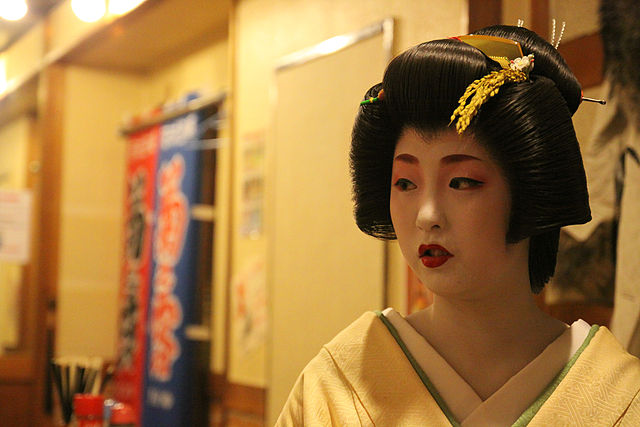
The glamorous women known as ‘geisha’ are a world-famous symbol of Japan. In Kyoto, where the geisha’s art of hospitality and refinement began and continues to this day, these women are known as ‘geiko’ and ‘maiko.’ They preserve the warm Japanese tradition of hospitality, sharing entertainment and conversation with clients, as well as lending their charm to the streets of Kyoto by night. Geiko and maiko combine beauty and glamor with hard work and the pursuit of perfection to delight their guests and preserve the traditions of old Japan.
The term ‘geiko’ refers only to fully-fledged geisha who have achieved accomplishment with artistic, cultural and social skills. ‘Maiko,’ on the other hand, are apprentices, usually under the age of twenty, who are still studying to perfect their skills. Geiko and maiko can be distinguished by their appearance. Maiko wear colorful kimono and adorn their hair with many dramatic floral ornaments. They wear tall platform sandals that give them a dainty appearance when walking, and in general present a more dramatic, showy appearance. Geiko, on the other hand, wear more subdued colors, one or two simple yet elegant hair ornaments, and ordinary Japanese sandals. They present a more demure, refined appearance. Both geiko and maiko apply white makeup to set off their lovely kimono. The makeup emphasizes contrast between black, white and red hues and is one of the most distinctive parts of a geiko’s or maiko’s appearance.
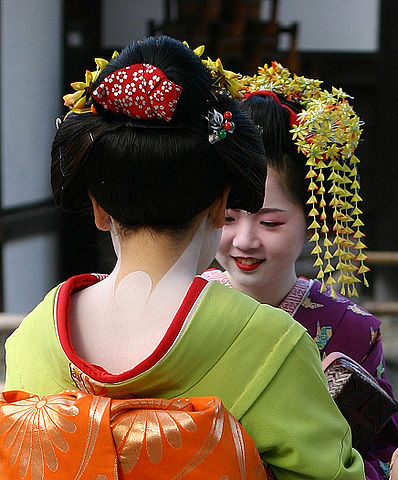
“The flowers of Kyoto” known as geiko and maiko delight the senses of their clients with references to the changing seasons, an important consideration in Japanese culture. Geiko and maiko carefully choose their kimono to suit the time of year perfectly: a bright pattern of scattered cherry blossoms celebrates spring, while a kimono featuring cool, flowing water is a refreshing sight in early summer. Even a geiko’s name cards, which she distributes to guests as a memento of their time spent together, thoughtfully reflect the season.
Geiko and maiko devote themselves to the art of hospitality. The happiness and comfort of guests come before all else in a geiko’s or maiko’s life and work. Geiko and maiko entertain their guests with dance and the music of traditional instruments such as the shamisen, a three-stringed banjo. Geiko and maiko are also responsible for keeping the conversation amongst their guests lively and bright. Games, particularly drinking games, also help to enliven a party and to relax guests, so geiko and maiko are responsible for teaching their clients simple games to break the ice. The beautiful, refined appearance of a geiko or maiko as she dances, pours tea, and chats also brings a sense of pleasure to her clients.
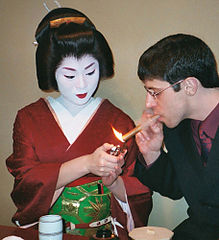
Secrecy is of utmost importance in the world of geiko and maiko. The art of the geiko first emerged in the 14th and 15th century in Kyoto, Japan’s former capital. Kyoto was the site of constant political intrigue, much of which was plotted in the teahouses where geiko ply their trade to this day. Because geiko were often privy to important clandestine meetings, secrecy and discretion became essential to the geiko. Even today, many important business dealings are negotiated in teahouse meetings with geiko and maiko present, so geiko and maiko must never reveal anything overheard from a client.
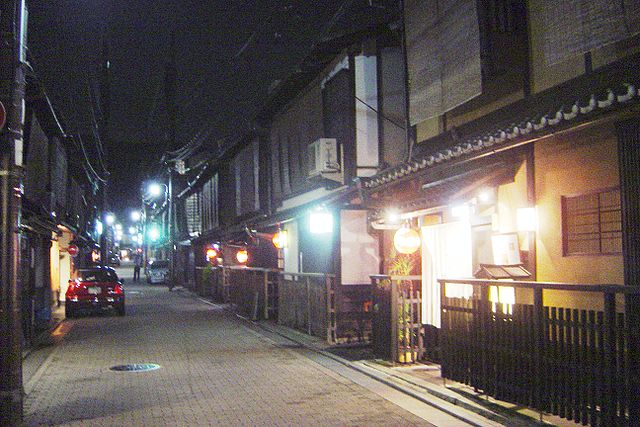
Kyoto, Japan’s ancient capital, is home to most of the geiko and maiko in Japan, with five distinct geiko districts called kagai, or “flower towns.” The largest, Gion Kobu, hosts more than one hundred such women, who live and train together as maiko in traditional houses and who work in teahouses called “ochaya.” There are sixty-four teahouses in Gion Kobu, all of which are designed to offer comfort and entertainment to their customers. Floored with tatami mats and appointed with spare, yet elegant, furnishings, a teahouse is at once cozy and refined. After food has been delivered by specialized caterers, geiko and maiko appear and see to the comfort of their guests. Geiko and maiko relax their guests and facilitate an easy socialization between them. Guests enjoy being able to meet people who may be different in age or background from the people with whom they ordinarily socialize, while geiko and maiko ensure that the relationships proceed smoothly. Since business is often discussed at these gatherings, it is essential that all of the guests remain comfortable and satisfied. The fate of a delicate negotiation can depend on the skill of the geiko and maiko in creating an easy atmosphere for business and socialization.
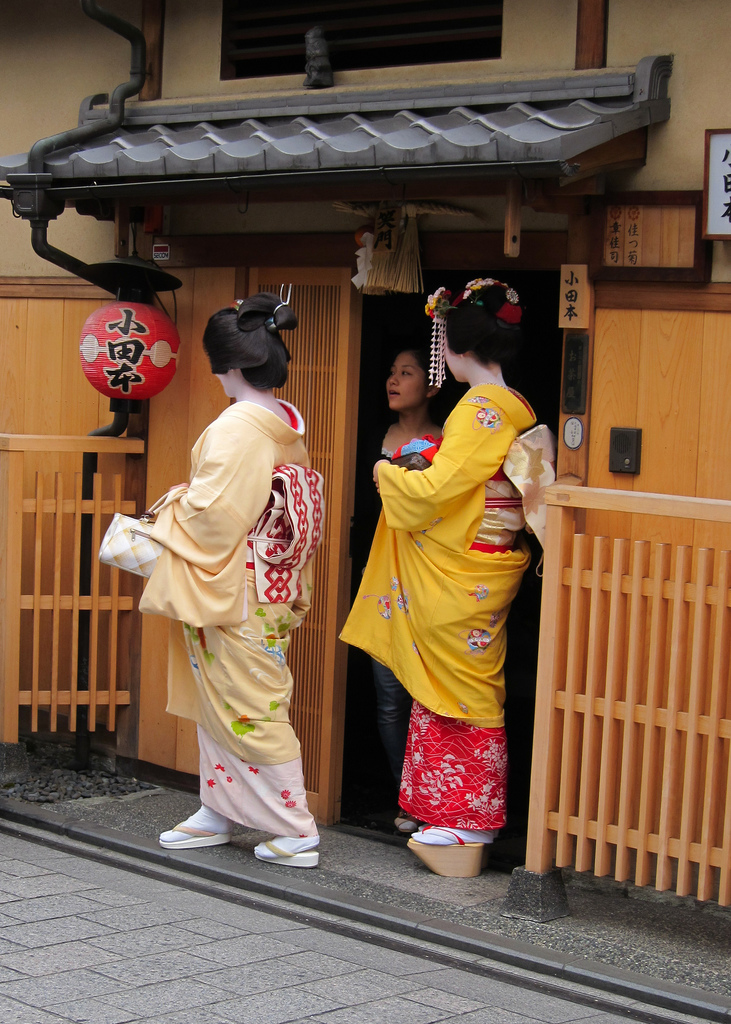
Although geiko and maiko present a glamorous appearance, their daily lives are far from easy. Young women hoping to become maiko often leave their families around the age of fifteen to come to Kyoto, where they live and study. Several maiko live together in a house with a proprietress, who instructs them in deportment, speech, and many of the detailed aspects of a geiko’s life. The girls attend lessons from early in the morning, learning traditional dance and music as well as cultural arts such as the tea ceremony. Teachers correct a maiko strictly on every aspect of her art, striving for perfection in each detail. Maiko must then entertain at teahouses late into the night, and begin the process again the following day. Maiko receive only two days off per month, and because they must maintain a certain image of old-world refinement, are forbidden from partaking in some of the most common aspects of modern teenage life, such as carrying mobile phones. Maiko must often communicate with their families by letter, and usually have few friends besides other maiko. At the age of twenty, most maiko must consider whether they are prepared to continue their hard work and training in order to become a full-fledged geiko, or whether they will return to their ordinary modern lives. Despite the difficulty of a maiko’s journey, geiko and maiko remain an essential component of the landscape of old Kyoto, and an enduring icon of the grace and hospitality of Japan.

Photo credits:
- http://en.wikipedia.org/wiki/File:Geisha-kyoto-2004-11-21.jpg
- http://en.wikipedia.org/wiki/File:Miehina_inaho.jpg
- http://en.wikipedia.org/wiki/File:Tokyo_Geisha_with_Shamisen_c1870s,.jpg
- http://en.wikipedia.org/wiki/File:Geisha,_maiko,_shikomi_in_Kyoto.jpg
- http://en.wikipedia.org/wiki/File:Geisha_Kyoto_Gion.jpg
- http://en.wikipedia.org/wiki/File:Japan_Kyoto_Gion_DSC00827.jpg
| Aucun commentaire |


















